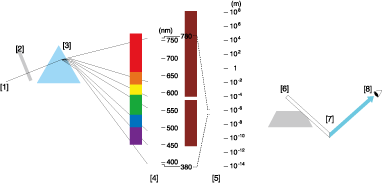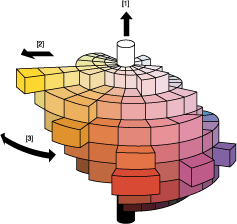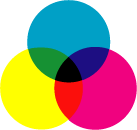Three Primary Colors and the Three Attributes of Color
Three Primary Colors
Why do objects appear to have color when placed in a bright location? Light is a visible ray that is an electromagnetic wave with a wavelength of 380 nm to 780 nm. Visible light can be divided into the seven prismatic colors of violet, indigo, blue, green, yellow, orange, and red, from the color with the shortest wavelength. On the contrary, when the lights of all these colors combine, a colorless white light (sunlight) is produced. Colors of an object is registered by the human eye as colors because the visible light reflected off or passing through an object changes its wavelength and intensity.
[1]: White light / [2]: Slit / [3]: Prism / [4]: Visible ray / [5]: Electromagnetic wave / [6]: Light / [7]: Reflection / [8]: Color(s)
Visible light can be divided into primary colors. Primary colors cannot be created by mixing other colors. On the other hand, a whole variety of colors can be created by mixing the primary colors. The two concepts of color mixing are the three primary colors of light and those of pigment. Using the three primary colors of light for color mixture is also called additive color mixing, in which the more the colors are mixed, the brighter the produced color will be. Specifically, the red (R), green (G), and purplish blue (B) lights are mixed to create different colors. Using the three primary colors of pigment for color mixture is also called subtractive color mixing, in which the more the colors are mixed, the darker the produced color becomes. Dyes and toners of yellow (Y), magenta (M), and cyan (C) are combined to create various colors, but in application black (K) is also required to fully reproduce colors.
Three Primary Colors of Light | Three Primary Colors of Pigment |
|---|---|
|
|
Three Attributes of Color
Let's look at how humans identify color. When we see colors of an object, we think it is reddish or bluish, bright or dark, and vivid or dull. The sensation that we feel when we think an object is "reddish or bluish" is distinguished in terms of hue. "Bright or dark" is understood as color value (lightness), and "vivid or dull" is identified as saturation. These three elements are called the three attributes of color. The color solid (Munsell color system) shown below is a three-dimensional expression of the three attributes of color.
[1]: Color value (lightness) / [2]: Saturation / [3]: Hue


